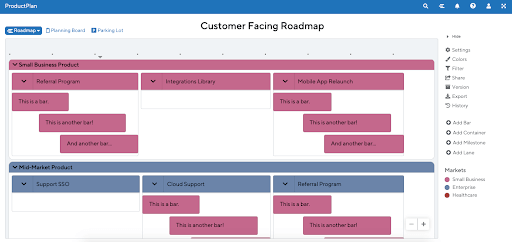There are specific fundamental strategies and smart practices that apply to build any roadmap. But a roadmap developed for public consumption—meaning your customers, prospects, and even competitors could see it—has a unique set of objectives, risks, and requirements.
So, if you’re planning to create a customer-facing roadmap, you’ll want to follow a few additional best practices. We’ll describe them in this post. First, though, let’s review what a customer-facing roadmap is, and why you’d want to create and share one.

What is a Customer-Facing Roadmap?
Most product roadmaps are created for internal use only. Product managers, developers, sales reps, executives, and other stakeholders across the company use the roadmap as a strategic guidepost to set the big-picture plan for the product and to make sure they’re staying on track with that plan.
But product teams don’t typically make these roadmaps available to people outside of the company. To share new product plans with customers and the broader market, businesses create marketing messages, public relations campaigns, and promotional collateral. Then, their sales reps can share it with prospects.
A customer-facing roadmap is not developed for the cross-functional product team itself. It is intended for the people likely to be interested in buying the product when it hits the market. For this reason, product managers view these roadmaps as a way to engage with their user persona. As we’ll discuss below, they look very different from traditional internal roadmaps.
Why Create a Customer-Facing Roadmap?
Publishing a customer-facing product roadmap can benefit a company in several ways. Product teams use them for many strategic reasons. Here are just a few.
1. Building anticipation in the market
When people in your target market can get a sneak peek at the plans behind your next new product, or a big enhancement to an existing one, that can generate enthusiasm among potential buyers. And that enthusiasm can translate into increased sales when your product launches.
2. Deepening relationships with customers
With increased competition in just about every industry, customers have become fickle and less likely to stay loyal to one company. So, how can you keep them thinking about your company during the periods when you don’t have a new product on the market?
One strategy is to share a high-level overview of what you have in the works—with a customer-facing roadmap. Getting a chance to see your plans well in advance of the product release can make your customers and prospects feel more connected to your company. That can help keep your customer relationships strong even when you don’t have anything new for them to buy.
3. Gaining valuable market feedback
A product manager can also use a customer-facing roadmap as a tool to validate the team’s plans for the new product. When they share their roadmap publicly, product teams can review the market’s response and feedback for valuable business intelligence into what aspects of the new product are already resonating with users—and which ones aren’t.

6 Tips for Creating a Customer-Facing Roadmap
Now that we’ve reviewed what a customer-facing roadmap is and some of its strategic benefits, let’s discuss tips for developing one for your company’s product.
1. Use a roadmap app
Your customer-facing roadmap is not going to look much like the internal roadmap you create just for your team. For that reason (and plenty others), you want to use the right tool for the job: a web-based app designed specifically for roadmapping.
Think about it. Every time you create a new roadmap or even a slightly different version of your existing one, you want the process to be as simple and painless as possible. If you’re still using spreadsheets, word processing documents, or presentation slideshows to create your roadmaps, it’s going to take a lot of tedious manual work to develop a new customer-facing roadmap from scratch.
The last thing you want to do is accidentally copy something from an internal roadmap onto your customer-facing roadmap that wasn’t meant to be shared publicly (such as the estimated completion date).
With the right roadmap app, you can create your customer-facing roadmap in minutes.
2. Assume your competitors will see it
You need to assume that everyone will see your customer-facing roadmap as soon as you share it: industry analysts, your company’s toughest media critics, even your competitors. It doesn’t matter how carefully you release the roadmap.
Even if you send it only to a list of qualified leads and your most loyal customers, you need to make sure nothing is on the roadmap that the market could use against you. The practical takeaway from this: Don’t share too much detail on functionality.
3. Don’t overpromise
Once you’ve made your customer-facing roadmap public, that first version becomes a permanent part of the public record. You can always update your customer-facing roadmap later. This becomes much easier if you’re using the right roadmap app—because you can keep only a single up-to-date version online and just send out the link to it.
Still, if you include details about specific features, pricing, or—most dangerous of all—a date you expect to release the product—your customers will take those as promises. And once you’ve made that promise publicly, even if you adjust the roadmap later and change it, the customers who read it will still hold you to it.
This is where a customer-facing roadmap can backfire—especially amongst your most enthusiastic customers and prospects. If you set expectations on this roadmap and then can’t meet them, you could turn what could’ve been loyal customers into disappointed critics.
4. Highlight the cool stuff—and nothing else
Traditional product roadmaps, the ones for internal company use only, can cover a wide range of strategic plans and goals. Product teams often use roadmaps to prioritize things like revenue expectations, addressing technical debt, building backend functionality, and ways to overtake a competitor. You do not want any of these elements in your customer-facing roadmap.
As we discussed above, public roadmaps can help product teams deepen their relationships with customers and prospects. Sharing what feels like an internal document with your user personas can make those people feel more connected to your company. They feel privy to the “behind the scenes” work you’re doing.
5. Make it a two-way conversation
As we pointed out earlier, one strategic benefit of a customer-facing roadmap is that it can lead to useful market feedback. But to capitalize on this business intelligence, you need to allow the public to react to your roadmap. Then, your team can analyze those reactions and update your plans accordingly.
Encourage the customers and prospects who see your public roadmap to weigh in with their thoughts. Send out surveys asking what they like and don’t like about your planned product. Contact some of your customers for a conversation after you’ve shared the roadmap with them. And invite the market to respond to you directly with feedback about what they’ve seen on your roadmap.
6. Don’t let your customer-facing roadmap get stale
If you take our advice and use a web-based roadmap app to build and share your customer-facing roadmap, you’ll also need to check in with it regularly. Make sure your team is still on track with the cool stuff you’ve highlighted on the roadmap.
Sharing a roadmap with the public is a significant commitment. Assume that existing users, prospects, industry reporters, influencers in your industry—and, yes, your competitors—are looking at the roadmap every day. With that in mind, refer to it often to make sure everything you’ve included on the roadmap is still accurate.




